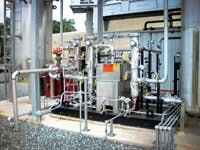Envision a biogas system that offers a municipal wastewater treatment plant energy self-sufficiency and is 100% privately financed. One municipality is turning that into a reality.
The village of Ridgewood, N.J., has arranged a public-private partnership with Ridgewood Green RME, an entity composed of Natural Systems Utilities, Middlesex Water Co., and American Refining and Biochemical, to transform liquid carbon waste into energy. The project, designed by HDR, uses biogas recovery, treatment and a combined heat and power system to improve air quality and lower energy costs at the village’s water pollution control plant. Energy produced on site by an anaerobic digestion process that captures methane is converted to power. The project lowers the village’s carbon footprint and converts wastes to electricity. The project launched in December 2011, and the new assets have been fully operational since early 2013.
Project Overview
A biogas production system was designed to optimize the production of electricity from methane, and was constructed through a retrofit at the existing water pollution control facility. Ridgewood Green RME, through a 20-year public-private partnership with the village of Ridgewood, made the upfront capital investment to retrofit the new equipment to optimize the anaerobic digestion process and convert methane gas to electricity. Bio-Organic Catalyst Inc. also helped develop the project and continues to provide an enzyme product that increases biogas production. In addition, the production of electricity is enhanced through co-digestion with food wastes such as brown grease to increase biogas production. The heat required for anaerobic digestion also is generated by heat recovery off of the engine, further increasing plant efficiency and reducing emission of greenhouse gases. In turn, this biogas conversion facility now eliminates the need to flare the methane into the atmosphere.
The process starts with a liquid waste receiving station with an 11,000-gal receiving tank, feed pump and mixing pump. Waste is delivered to the plant by trucks and pumped through screens into an insulated, heated receiving tank. This feedstock then is fed from the receiving tank into the plant’s existing anaerobic digester. Excess digester treatment capacity is put to use by a liquid waste receiving, holding and feeding system that significantly increases biogas production.
Instead of flaring the excess biogas, it enters a conditioning system that removes impurities such as hydrogen sulfide and siloxanes. After it is conditioned, the biogas is fed into a new combined heat and power reciprocating engine that generates electricity for the treatment plant and heat for maintaining the digester operating temperature.
Renewable Energy
The plant’s design repurposes equipment already on site and is focused on efficiency from start to finish. In fact, the plant will reduce its power costs significantly under a 20-year agreement with Ridgewood Green RME.
The new system will create 240 kW of electricity, enough to power the treatment plant and heat the digester to operating temperature while lowering the carbon footprint.
Additionally, four solar generation facilities were constructed on several properties throughout Ridgewood to provide renewable energy. Installations at the village hall, fire department, EMS building and water pollution control facility have been producing electricity since February 2013. The biogas engine—the workhorse of the project—has undergone energy optimization testing and has been successfully integrated into the wastewater treatment process. The facilities are being operated by village employees in concert with Ridgewood Green RME.
In addition to cost savings from the utility bill, additional income is generated by selling all of the renewable energy certificates (RECs) to 3Degrees, a provider of renewable energy. RECs produced by the biogas technology at Ridgewood and the related solar projects have a relatively high value because of their unique characteristics, compared with other Green-e Certified National RECs. 3Degrees is purchasing Ridgewood’s premium RECs and, in turn, supplying the Ridgewood water pollution control plant with lower cost Green-e Certified National RECs, equivalent to almost the entire plant’s energy needs, thereby ensuring the plant is powered with renewable energy, while maximizing the project’s return on investment. The sale of these RECs is part of the overall economic package that allows for the supply of lower-cost electricity, ultimately benefiting Ridgewood utility customers.
Already recognized for its forward thinking, the public-private partnership project was recognized as the Municipal Renewable Energy Project of the Year by the American Biogas Council (ABC). The ABC awards recognize projects that make a significant impact on the development of the biogas industry. The organization represents more than 200 companies dedicated to maximizing the production and use of biogas from organic waste.
Download: Here


